AIRBUS Bundle
How Does Airbus Soar Above the Competition?
Airbus, a European aerospace powerhouse, is a global leader in aircraft design and manufacturing, consistently pushing the boundaries of aviation technology. A recent order for 100 A321neo aircraft highlights its ongoing dominance in the commercial aircraft sector. This article delves into the intricacies of AIRBUS SWOT Analysis, exploring its operations and strategic advantages.
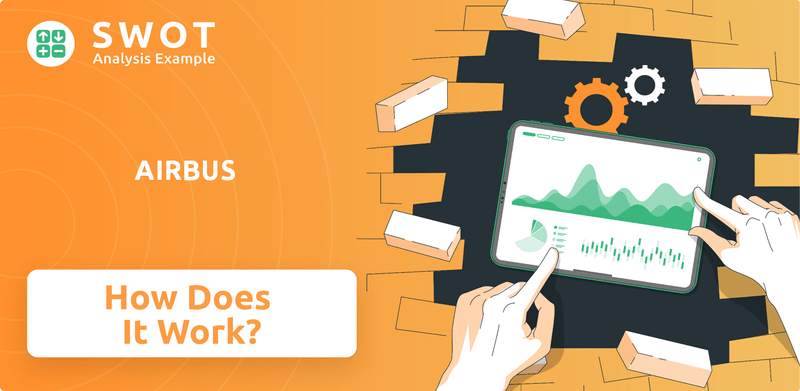
From its rich Airbus history to its cutting-edge Airbus manufacturing processes, understanding the Airbus company is key for anyone interested in the future of air travel. This analysis will dissect how Airbus operates, its diverse product range, and its strategies for sustained growth. We'll explore how Airbus aircraft are designed, manufactured, and delivered, providing a comprehensive view of this industry giant.
What Are the Key Operations Driving AIRBUS’s Success?
The Airbus company creates value by designing, manufacturing, and selling a broad range of aerospace products and related services. Its core offerings include commercial aircraft, military aircraft, helicopters, and space systems. These products serve a diverse customer base, including airlines, governments, and private entities globally.
The operational processes are highly complex and integrated. Manufacturing involves a global supply chain with components sourced from numerous countries, followed by final assembly lines in locations such as Toulouse, France; Hamburg, Germany; Tianjin, China; and Mobile, USA. Technology development is central, with significant investments in research and development to enhance fuel efficiency, reduce emissions, and introduce advanced avionics.
Logistics plays a critical role in managing the vast network of suppliers and ensuring timely delivery of parts. Sales channels are direct, involving extensive negotiations with airlines and governments, often spanning years. Customer service extends beyond delivery, encompassing maintenance, training, and upgrades, which are crucial for long-term customer relationships and operational efficiency. Airbus's supply chain is a key differentiator, leveraging a vast network of suppliers and strategic partnerships to ensure production continuity and manage costs.
The Airbus manufacturing process is a complex, global operation. It involves sourcing components from a vast network of suppliers worldwide. Final assembly occurs at facilities in Europe, China, and the United States. This distributed model allows for efficient production and access to diverse expertise.
Airbus offers a wide range of aircraft. The A320 family is a best-seller, known for its fuel efficiency. The A350 is a long-range wide-body aircraft. Airbus also produces military aircraft, helicopters, and space systems.
Customer service is a critical aspect of Airbus's operations. It includes maintenance, training, and upgrades. These services ensure the long-term performance and reliability of Airbus aircraft. Strong customer relationships are essential for repeat business.
The Airbus supply chain is a global network. It involves numerous suppliers and strategic partnerships. This network ensures production continuity and cost management. Efficient supply chain management is crucial for timely delivery.
Airbus's operational uniqueness lies in its ability to manage highly complex, large-scale engineering and manufacturing projects with stringent safety and performance requirements. This translates into customer benefits such as reliable and fuel-efficient aircraft, advanced defense capabilities, and robust space infrastructure, ultimately differentiating Airbus in the market through its technological prowess and global support network. The company's focus on innovation and sustainability, including the development of hydrogen-powered aircraft, further enhances its value proposition.
- Airbus delivered 735 commercial aircraft in 2023.
- The A320 family remains a key driver of revenue, with continuous improvements in fuel efficiency.
- Airbus invests heavily in R&D, with a focus on sustainable aviation fuels and emission reduction.
- The company's order backlog provides a strong foundation for future growth.
AIRBUS SWOT Analysis
- Complete SWOT Breakdown
- Fully Customizable
- Editable in Excel & Word
- Professional Formatting
- Investor-Ready Format
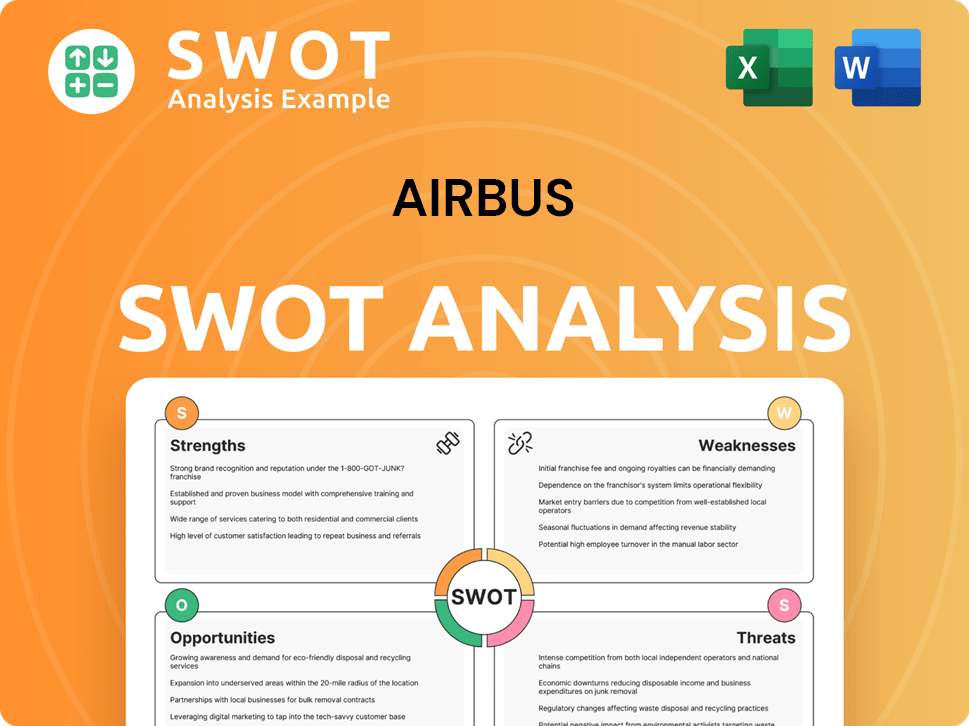
How Does AIRBUS Make Money?
The Airbus company generates revenue through a diverse set of streams, primarily stemming from its core divisions: Commercial Aircraft, Helicopters, and Defence and Space. The company's monetization strategies are designed to maximize returns across the entire lifecycle of its products, from initial sales to ongoing services.
A significant portion of Airbus's revenue comes from selling commercial aircraft, including direct sales to airlines and leasing companies. Additionally, the company focuses on services such as maintenance, spare parts, and upgrades, which contribute to recurring revenue. The Defence and Space division further diversifies revenue through military aircraft, satellites, and government contracts.
In 2023, Airbus delivered 735 commercial aircraft, showcasing strong demand. The Services segment saw an 11% increase in revenue, reaching €4.6 billion, highlighting its growing importance. This diversification helps stabilize income, complementing the cyclical nature of aircraft manufacturing.
This is the primary revenue source, involving the sale of new aircraft to airlines and leasing companies.
Includes maintenance, spare parts, upgrades, and training, providing recurring revenue streams.
Revenue from military aircraft, satellites, launch vehicles, and associated services.
Sales of civil and military helicopters, along with MRO (Maintenance, Repair, and Overhaul) services.
These agreements offer comprehensive support packages that combine aircraft sales with ongoing services.
Pricing strategies vary based on aircraft configurations and the level of service provided.
The Airbus strategy involves a focus on expanding its services segment to create a more stable revenue base. This is crucial given the cyclical nature of the aircraft manufacturing market. Understanding the target market of Airbus is essential for appreciating its revenue strategies.
Airbus uses several key strategies to maximize revenue and ensure customer loyalty.
- Direct Sales: Selling new aircraft to airlines and leasing companies.
- Service Contracts: Providing maintenance, repair, and overhaul services.
- Spare Parts: Supplying components for aircraft maintenance.
- Upgrades: Offering modifications and enhancements to existing aircraft.
- Long-Term Agreements: Bundling sales with comprehensive support.
AIRBUS PESTLE Analysis
- Covers All 6 PESTLE Categories
- No Research Needed – Save Hours of Work
- Built by Experts, Trusted by Consultants
- Instant Download, Ready to Use
- 100% Editable, Fully Customizable
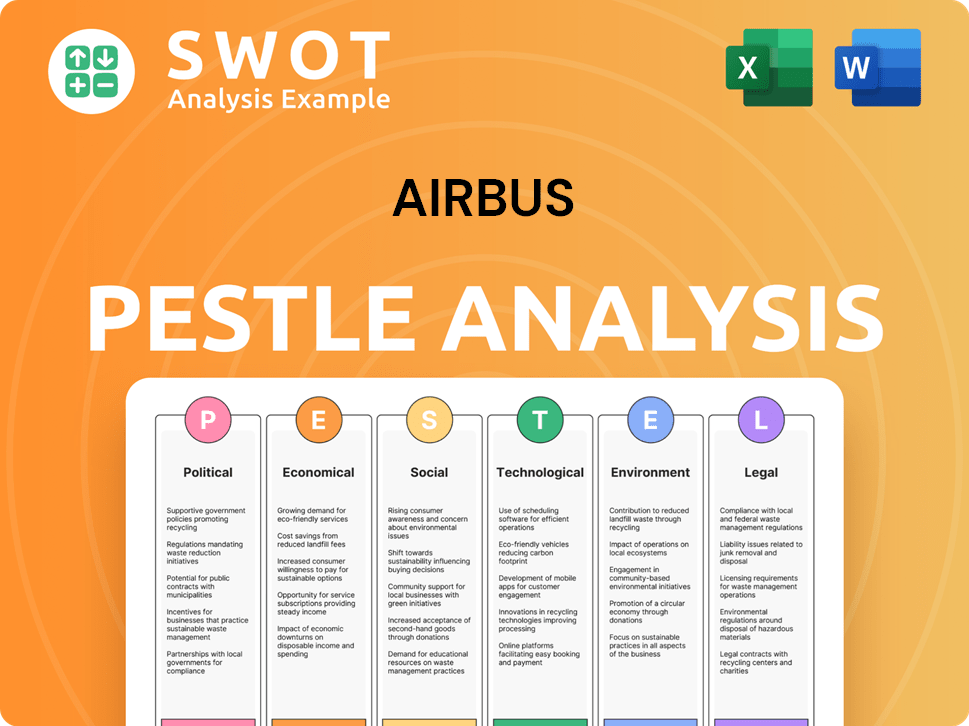
Which Strategic Decisions Have Shaped AIRBUS’s Business Model?
The Airbus company has a rich history marked by significant milestones and strategic decisions. Its journey began with the launch of the A320 family in the 1980s, which introduced fly-by-wire technology to commercial aviation. This move significantly boosted Airbus's market share and set the stage for future innovations in the Airbus aircraft industry.
Another key milestone was the development and launch of the A380, the world's largest passenger airliner. While the A380 faced production challenges, it showcased Airbus's engineering capabilities. More recently, the ongoing ramp-up of A320neo family production and the successful entry into service of the A350 XWB have been crucial for its commercial success. The company has also navigated operational challenges, including supply chain disruptions, impacting delivery schedules. For instance, in early 2024, Airbus adjusted its delivery targets due to ongoing supply chain complexities, highlighting the sensitivity of its operations to external factors.
Airbus's competitive advantages are multifaceted, including brand strength, technology leadership, and economies of scale. The company continuously adapts to new trends and competitive threats by investing in research and development. This forward-looking approach ensures its sustained relevance and competitive edge in a rapidly evolving industry. These factors collectively contribute to the company's strong position in the global aviation market.
The A320 family launch in the 1980s introduced fly-by-wire technology, boosting market share. The A380, though facing production halts, demonstrated engineering capabilities. The A320neo and A350 XWB have been crucial for commercial success.
Focus on fuel efficiency and advanced avionics provides a strong edge. High-volume production and a global manufacturing footprint enable cost efficiencies. Investment in sustainable aviation fuels (SAFs) and hydrogen-powered aircraft.
Airbus's brand strength, built on decades of innovation, is a significant asset. Technology leadership in fuel efficiency and advanced avionics provides a strong edge. Economies of scale and a global support ecosystem enhance customer loyalty.
Supply chain disruptions have impacted delivery schedules. In early 2024, Airbus adjusted delivery targets due to supply chain complexities. These challenges highlight the sensitivity of Airbus operations to external factors.
Airbus benefits from strong brand recognition and technological leadership. The company's focus on fuel efficiency and advanced avionics helps it compete effectively. Airbus's global support network and economies of scale further strengthen its position.
- Brand Strength: Built on decades of innovation and reliable aircraft.
- Technology Leadership: Particularly in fuel efficiency and advanced avionics.
- Economies of Scale: Achieved through high-volume production and a global footprint.
- Global Support Ecosystem: Enhances customer loyalty and provides a competitive moat.
AIRBUS Business Model Canvas
- Complete 9-Block Business Model Canvas
- Effortlessly Communicate Your Business Strategy
- Investor-Ready BMC Format
- 100% Editable and Customizable
- Clear and Structured Layout
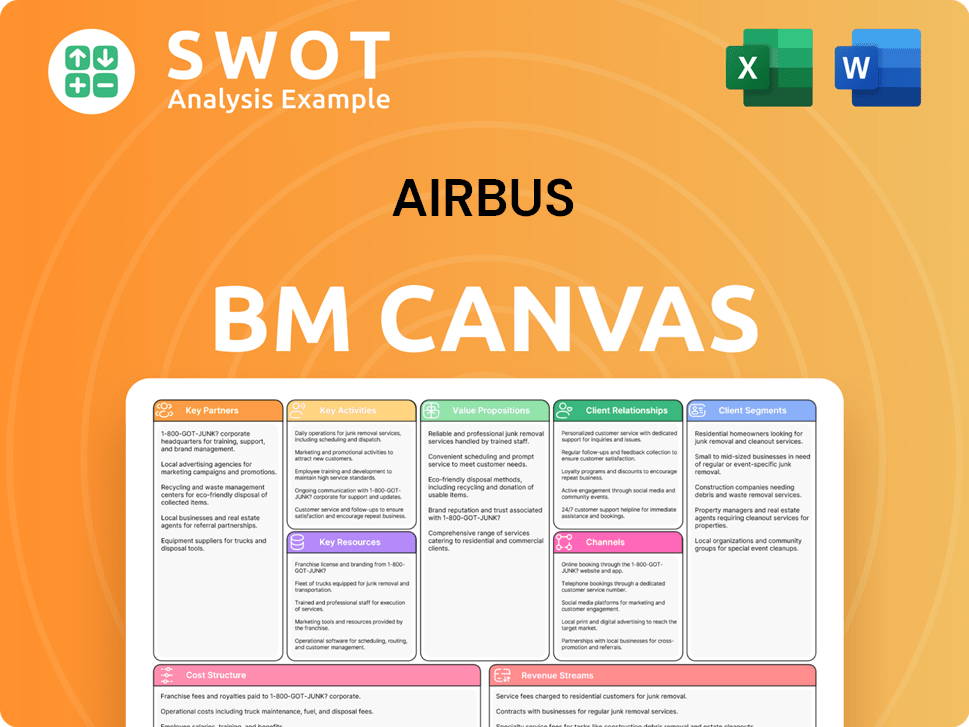
How Is AIRBUS Positioning Itself for Continued Success?
The Airbus company holds a prominent position in the global aerospace industry, primarily competing with Boeing in the large commercial aircraft market. It consistently vies for the largest share of new aircraft orders and deliveries, demonstrating strong market penetration. In 2023, Airbus maintained its lead in commercial aircraft deliveries for the fifth consecutive year, delivering 735 aircraft. Its global reach extends across continents, serving a vast network of airlines and governments, showcasing its extensive operational capabilities.
However, Airbus operations face several key risks. Regulatory changes related to environmental standards and aviation safety could necessitate significant investments in new technologies. Intense competition from its primary rival, as well as potential new entrants in specific market segments, constantly pressures pricing and innovation. Technological disruption, such as the rapid development of electric or hybrid aircraft, could shift market dynamics if not adequately addressed. Geopolitical tensions and economic downturns also pose risks, impacting travel demand and airline profitability.
Airbus is a leading player in the aerospace sector, known for its commercial aircraft. It competes directly with Boeing, forming a duopoly in the large commercial aircraft market. Its strong market presence is evident through its consistent aircraft deliveries and global customer base.
Airbus faces risks from environmental regulations and safety standards, requiring investment in new technologies. Competition from Boeing and potential new entrants puts pressure on pricing and innovation. Technological disruptions, such as electric aircraft, could also impact the market.
Airbus is focused on sustainability, including zero-emission aircraft and sustainable aviation fuels. The company is investing in digitalization and autonomous technologies. Airbus plans to innovate, grow its services, and expand into new markets, while navigating supply chain and geopolitical challenges.
Airbus is actively pursuing sustainability initiatives and investing in digitalization. The company is committed to decarbonizing aviation and maintaining its technological leadership. Strategic expansion and innovation are key to its future plans.
The company's strategic focus includes sustainability, digitalization, and technological leadership in the aviation sector. Airbus aims to maintain its competitive edge through innovation and strategic market expansion. These initiatives are critical for long-term growth and resilience, as detailed in the Growth Strategy of AIRBUS.
- Sustainability: Development of zero-emission aircraft and sustainable aviation fuels.
- Digitalization: Investment in technologies to enhance operational efficiency.
- Market Expansion: Strategic growth into new markets while navigating global supply chains.
- Innovation: Continuous improvement of product lines and services.
AIRBUS Porter's Five Forces Analysis
- Covers All 5 Competitive Forces in Detail
- Structured for Consultants, Students, and Founders
- 100% Editable in Microsoft Word & Excel
- Instant Digital Download – Use Immediately
- Compatible with Mac & PC – Fully Unlocked
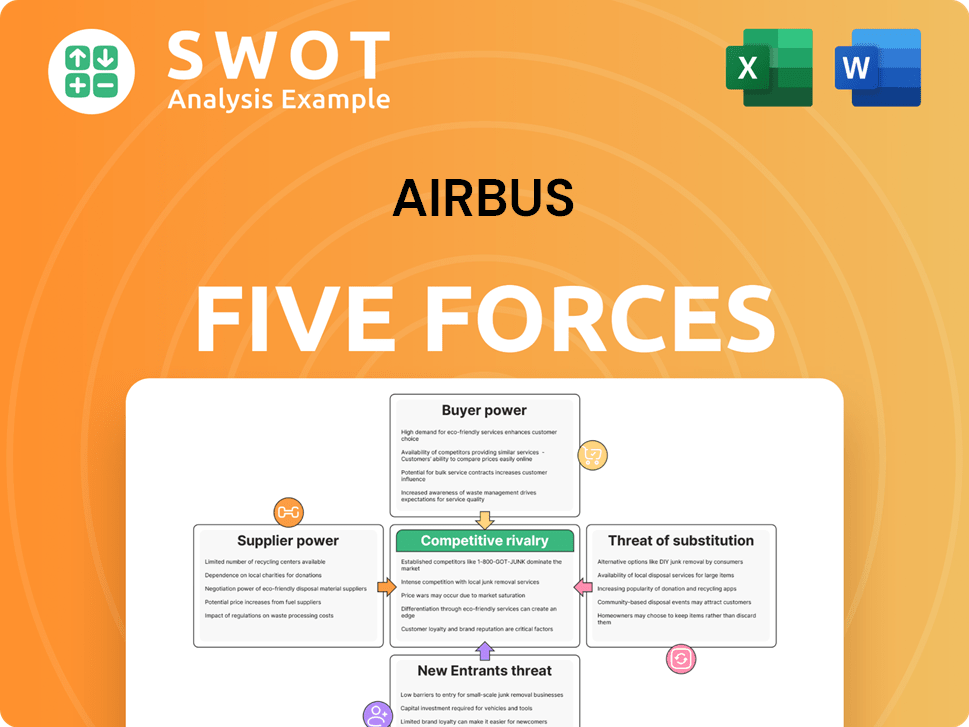
Related Blogs
- What are Mission Vision & Core Values of AIRBUS Company?
- What is Competitive Landscape of AIRBUS Company?
- What is Growth Strategy and Future Prospects of AIRBUS Company?
- What is Sales and Marketing Strategy of AIRBUS Company?
- What is Brief History of AIRBUS Company?
- Who Owns AIRBUS Company?
- What is Customer Demographics and Target Market of AIRBUS Company?
Disclaimer
All information, articles, and product details provided on this website are for general informational and educational purposes only. We do not claim any ownership over, nor do we intend to infringe upon, any trademarks, copyrights, logos, brand names, or other intellectual property mentioned or depicted on this site. Such intellectual property remains the property of its respective owners, and any references here are made solely for identification or informational purposes, without implying any affiliation, endorsement, or partnership.
We make no representations or warranties, express or implied, regarding the accuracy, completeness, or suitability of any content or products presented. Nothing on this website should be construed as legal, tax, investment, financial, medical, or other professional advice. In addition, no part of this site—including articles or product references—constitutes a solicitation, recommendation, endorsement, advertisement, or offer to buy or sell any securities, franchises, or other financial instruments, particularly in jurisdictions where such activity would be unlawful.
All content is of a general nature and may not address the specific circumstances of any individual or entity. It is not a substitute for professional advice or services. Any actions you take based on the information provided here are strictly at your own risk. You accept full responsibility for any decisions or outcomes arising from your use of this website and agree to release us from any liability in connection with your use of, or reliance upon, the content or products found herein.